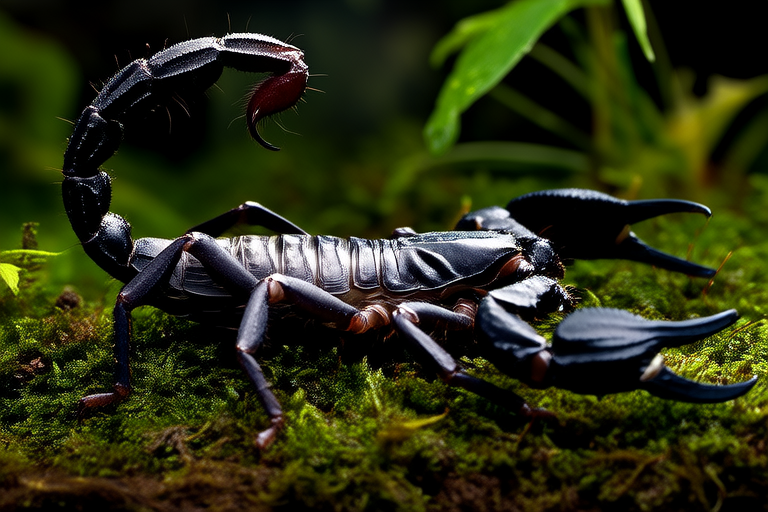
The Unique Needs of Heterometrus Spinifer: A Guide for New Owners
Welcome to the world of exotic pets! If you’re considering adopting a Heterometrus spinifer, also known as the Indian forest scorpion, you’ve chosen an intriguing and fascinating creature. This guide aims to provide you with all the necessary information to ensure your new pet’s well-being and a harmonious relationship between you and your scorpion.
Understanding Heterometrus Spinifer
Heterometrus spinifer is a species of scorpion native to Southeast Asia, particularly India, Sri Lanka, and parts of Indonesia. They are medium-sized scorpions, growing up to 10 cm in length. Their distinctive appearance features a dark brown or black body, and they possess prominent spines on their pedipalps (claws), which give them their name. These scorpions are generally docile and prefer to avoid confrontation, making them suitable for experienced and responsible owners.
Selecting an Appropriate Enclosure
Choosing the right enclosure is crucial for the health and happiness of your Heterometrus spinifer. The enclosure should be escape-proof, secure, and spacious enough to allow your scorpion to move around freely. A 10-gallon tank is usually sufficient for a single adult. Ensure that the enclosure has a secure lid with ventilation holes, as scorpions require fresh air.
The substrate in the enclosure should be at least 3-4 inches deep, allowing your scorpion to dig and burrow. Coconut fiber, bark chips, or a mixture of sand and soil works well. Avoid using gravel or small particles, as they can be ingested accidentally.
Creating the Ideal Habitat
Heterometrus spinifer thrive in tropical environments, so maintaining the correct temperature and humidity levels is essential. The ideal temperature range for this species is between 75°F and 85°F (24°C to 29°C). You can achieve this by using under-tank heating pads or ceramic heat emitters. Always monitor the temperature with a reliable thermometer.
Maintain a humidity level of 60-80% to prevent dehydration. Use a hygrometer to monitor humidity levels and mist the enclosure daily if necessary. Providing a shallow water dish is important, but ensure it is not too deep, as scorpions can drown easily.
Dietary Needs
Your Heterometrus spinifer is primarily carnivorous, feeding on insects such as crickets, mealworms, and dubia roaches. Offer prey items that are no larger than half the size of the scorpion’s body to prevent choking. Feed your scorpion once every 7-10 days, adjusting the frequency based on its appetite and activity level. Gut-loading the prey items with nutritious foods before feeding them to your scorpion enhances its diet.
Handling Tips
Handling your Heterometrus spinifer requires caution and respect. These scorpions are generally docile, but they can sting if threatened or provoked. Always handle your scorpion gently, avoiding sudden movements. Use thick gloves or tongs to pick up your scorpion, minimizing direct contact. Regular handling can help your scorpion become more accustomed to your presence, reducing stress.
Behavioral Traits
Heterometrus spinifer are nocturnal creatures, active during the night and resting during the day. They prefer to remain hidden and will often burrow into the substrate to create a safe haven. Providing hiding spots, such as cork bark or half logs, allows your scorpion to feel secure. Observe your scorpion’s behavior regularly to understand its preferences and needs better.
Common Health Issues
Like any pet, Heterometrus spinifer can face health challenges. Dehydration is a common issue, especially if humidity levels are too low. Signs of dehydration include lethargy, sunken eyes, and a dry exoskeleton. Ensure your scorpion has access to clean water and maintain appropriate humidity levels.
Another potential issue is molting difficulties. During the molting process, your scorpion may appear pale and sluggish. Provide a humid hide box filled with moist substrate to aid the molting process. Avoid disturbing your scorpion during this time, as it is vulnerable.
Safety Precautions
While Heterometrus spinifer stings are not typically life-threatening to humans, they can cause pain and discomfort. Keep the enclosure out of reach of children and pets to prevent accidental contact. Wash your hands thoroughly after handling your scorpion and avoid touching your face until you have done so.
Ensure the enclosure is securely fastened to prevent escape. An escaped scorpion can pose a danger to both itself and others, as it may seek shelter in less-than-ideal locations.
Further Reading and Resources
To deepen your understanding of Heterometrus spinifer care and husbandry, consider exploring additional resources:
- Books: “Scorpions: A Complete Pet Owner’s Manual” by Dr. Mark Harvey and “The Scorpion Files: A Guide to the World’s Most Dangerous Invertebrates” by Dr. Bill Shear.
- Websites: The American Association of Zookeepers (AAZK) and the International Union for Conservation of Nature (IUCN).
- Forums: Online communities dedicated to exotic pets, where you can connect with other enthusiasts and gain valuable insights.
By following the guidelines outlined in this article, you can provide a nurturing environment for your Heterometrus spinifer and enjoy a rewarding companionship. Remember, responsible ownership involves ongoing learning and adaptation. With dedication and care, you’ll be able to offer your scorpion a fulfilling and healthy life.






